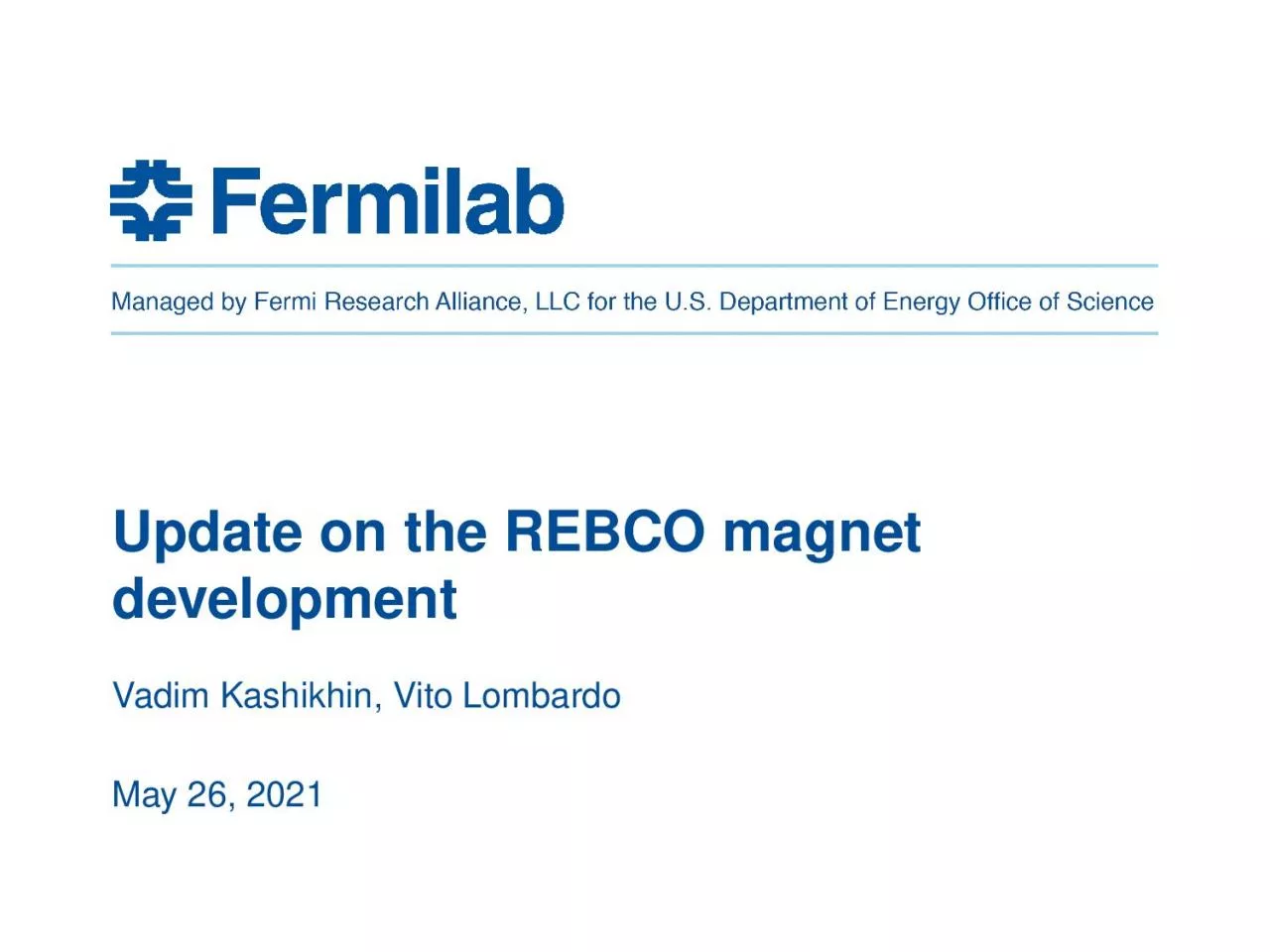

Vadim Kashikhin Vito Lombardo May 26 2021 REBCO magnet development 5262021 The projects objective is to address the US MDP goal 2 Develop and demonstrate an HTS accelerator magnet with a selffield of 5 T or greater compatible with operation in a hybrid HTSLTS magnet for fiel ID: 930225
Download Presentation The PPT/PDF document "Update on the REBCO magnet development" is the property of its rightful owner. Permission is granted to download and print the materials on this web site for personal, non-commercial use only, and to display it on your personal computer provided you do not modify the materials and that you retain all copyright notices contained in the materials. By downloading content from our website, you accept the terms of this agreement.
Slide1
Update on the REBCO magnet development
Vadim
Kashikhin
, Vito Lombardo
May 26, 2021
Slide2REBCO magnet development
5/26/2021
The project’s objective is to address the U.S. MDP goal #2: “Develop and demonstrate an HTS accelerator magnet with a self-field of 5 T or greater, compatible with operation in a hybrid HTS/LTS magnet for fields beyond 16T.” This is achieved through a series of steps:
Short sample studies to determine the bending degradation;
Initial COMB magnet demonstration (proof of principle) with a CORC® cable made of average-performance REBCO tapes; Performance demonstration to reach 5 T self field goal in the HTS accelerator magnet using the CORC® cable made of pre-sorted (high Je) REBCO tapes;Demonstration of the hybrid HTS/LTS magnet operation using a Nb3Sn coil outsert;Studies of the magnet parameter space to determine suitable designs and conductor requirements to reach 10 T standalone field and 5 T insert field. Driving questions for area IIb REBCO magnets to be addressed:What performances and architectures should the conductor have? How can we make magnets using these conductors?What is the maximum dipole field a REBCO magnet can generate? What is the long-term conductor and magnet performance under cycling Lorentz loads? What is the magnet performance? How does it quench? How can one protect the magnet during a quench? What is the field quality of REBCO accelerator magnets?How can we characterize the transport performance for long conductors?
V. Kashikhin, V. Lombardo | Update on the REBCO magnet development
2
Slide3Improved test setup at 77 K
5/26/2021
V. Kashikhin, V. Lombardo | Update on the REBCO magnet development
3
Testing the cables straight rather than bent to a large diameter to assess undisturbed cable performance and avoid a possible degradation.
Slide4Redesigned coil cross-section
5/26/2021
V. Kashikhin, V. Lombardo | Update on the REBCO magnet development
4
Changes vs. previous design:Removed one cable per quadrant from the inner layer;Increased the minimum pole width from 52 mm to 57 mm;Adjusted the radial layer position to allow two individual mandrels and winding from outside;
Vertical transition between the layers (rather than radial) to maximize the pole width.
Slide5Revised support design
5/26/2021
V. Kashikhin, V. Lombardo | Update on the REBCO magnet development
5
Single bend on the outer surface instead of 3 bends on the inner and outer surfaces.
52 mm
57 mm
Slide6I
c
retention before and after bending
5/26/2021
V. Kashikhin, V. Lombardo | Update on the REBCO magnet development6
1
st
set of tests2nd set of tests
Ic
retention increased from 49% to 54% (after the self-field correction).
Improvement, but not as much as expected based on ACT and LBNL data for relevant bending diameters.
Why?
Slide7FEM model of cable bending in COMB structure
5/26/2021
7
D
mandrel = 101.5 mm
D
pole
= 57.0 mm
D
cable
= 3.70 mm
e
max
= 0.0610
e
max
= 0.0671
Isotropic material properties. Symmetry condition at YZ plane.
Top cable was bent in one plane around the Y axis – uniaxial bending.
Bottom cable was bent in two planes around the Y and Z axes - biaxial bending.
10% higher strain in case of the biaxial bending vs. the uniaxial bending.
V. Kashikhin, V. Lombardo | Update on the REBCO magnet development
Slide8Effective strain vs. pole diameter
5/26/2021
8
Effective uniaxial bending diameter
D
mandrel
= const
V. Kashikhin, V. Lombardo | Update on the REBCO magnet development
Slide9Critical current retention in different tests
5/26/2021
9
V. Kashikhin, V. Lombardo | Update on the REBCO magnet development
Slide10Possible options for the first model
Use the coil cross-section/ends as is.
Around 50% degradation is to be expected with the available cable. Can be improved in future by optimizing the tape and cable parameters.
Can test both standalone and as part of a hybrid magnet.
Scale the coil cross-section to larger pole and mandrel diameters to achieve a targeted strain reduction.Can only be tested stand-alone. Will no longer fit as insert into a Nb3Sn coil.Since the total cable length is limited, the coil may become too short to be representable of an accelerator magnet.Partially flatten the coil ends to change biaxial bending to uniaxial bending for the pole turn.Some loss of the useable aperture;More complicated coil and support structure geometry, but should not be a problem for 3D printing.5/26/2021V. Kashikhin, V. Lombardo | Update on the REBCO magnet development10
Slide11Flattened coil ends
5/26/2021
V. Kashikhin, V. Lombardo | Update on the REBCO magnet development
11
The pole turns can be wound as flat racetracks with only uniaxial bending.
To make it possible, the curvature of the pole turns in XY plane should be subtracted from
all the turns:
makes the pole turns completely flat;
the rest of the turns become flattened to some degree.
Would “gain” ~10 mm in the equivalent pole diameter for the same coil cross-section and OD with the expected
I
c
retention of ~65%.
The vertical aperture becomes limited to ~80 mm, while the horizontal is unchanged at ~100 mm.
Slide12Model of the flattened coil ends (work in progress…)
5/26/2021
V. Kashikhin, V. Lombardo | Update on the REBCO magnet development
12
Traditional end
Flattened end